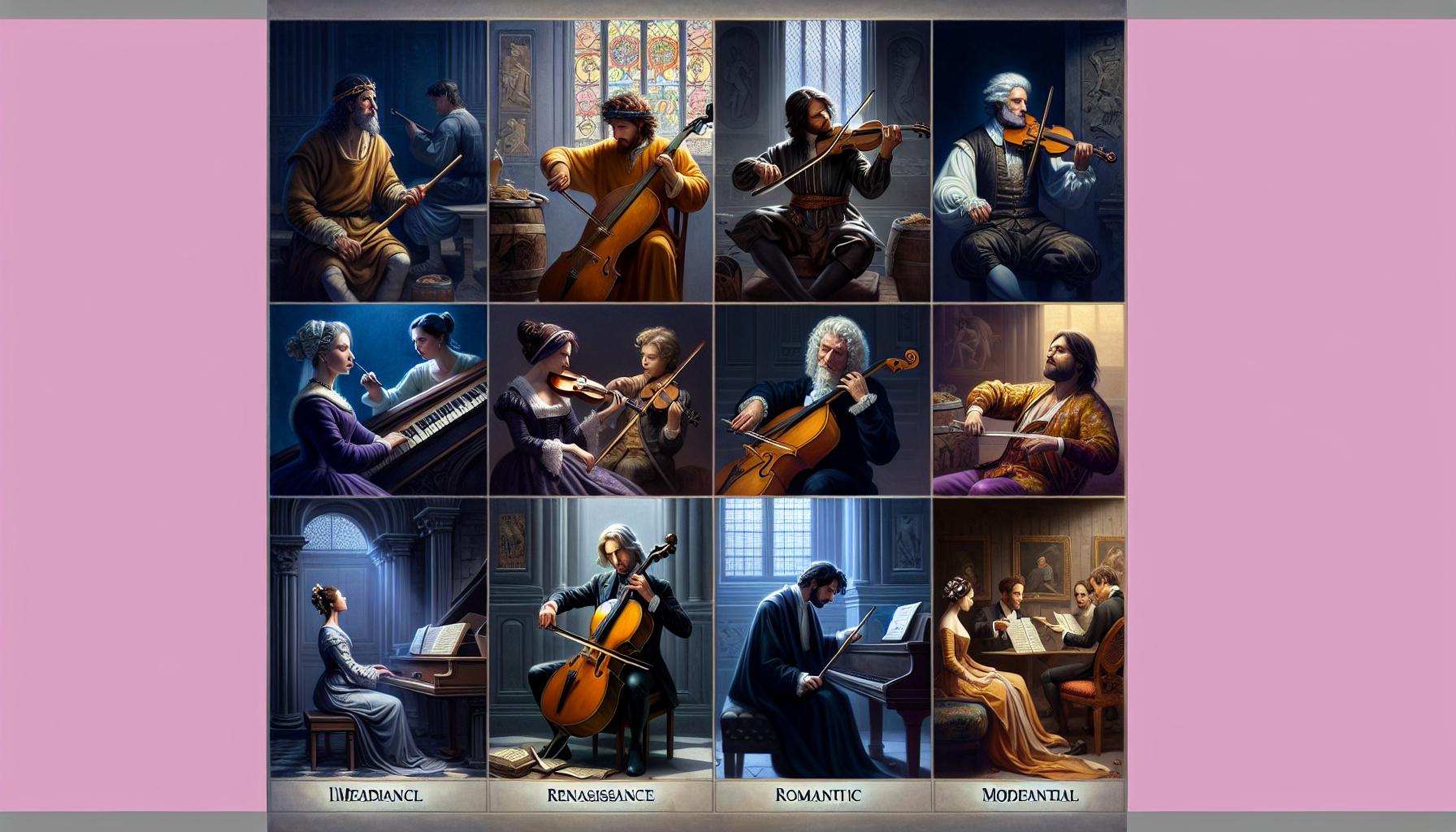Diving into the world of classical music, it’s impossible not to stumble upon the term ‘counterpoint’. It’s the backbone of many compositions, the underlying thread that weaves a complex, beautiful tapestry of sound. But what exactly is counterpoint, and why is it so important?
Counterpoint is more than just a technique; it’s an art form in itself. It’s the delicate balancing act of combining multiple independent melodies to create a harmonious whole. This isn’t just about layering sounds; it’s about crafting a musical conversation that’s engaging and dynamic.
In this article, we’ll explore the intricacies of counterpoint, its role in classical music, and how it has shaped the music we love today. So, whether you’re a seasoned musician or simply a lover of classical music, buckle up for a fascinating journey into the heart of musical composition.
Contents
Understanding Counterpoint
Let’s delve into the remarkable world of counterpoint. In essence, counterpoint is the juxtaposition of two or more independent melodies. It’s not just about creating a harmonious symphony but also emphasizes individuality within unity. It’s where multiple melodic lines run side by side, intertwining yet maintaining their distinctiveness. Astounding, isn’t it?
Indeed, constructing a piece of music with multiple melodies running concurrently calls for skill, creativity, and a deep understanding of the musical language. Consider this: each melodic line must stand on its own, yet when played together, these lines must support each other rather than clash. In other words, every melody should sing its own song, but part of a wider choir.
In counterpoint, every note brings a new dynamic to the melody, and the voices are not tied to one another. This gives each voice autonomy over its rhythm – sometimes we see them move together, while other times they might take their own paths. It’s an amazing demonstration of musical independence and interdependence.
Although counterpoint is often associated with classical music, let’s not limit it. Mastery in counterpoint has been demonstrated by musicians across all genres, from jazz masters to contemporary pop artists. It is undoubtedly a unique art form that brings out the beauty of individuality in unity.
Deep dive into counterpoint and you’ll find different types, each with its unique characteristic and rules. Of course, we’ll not dive into every single one of them now, but to give a flavor, let’s mention some – first species counterpoint, second species counterpoint and third species counterpoint to name a few.
Interestingly, these types form a vital dimension of composing music. They offer different layers of complexity and are often applied in different parts of a musical composition. Undoubtedly, counterpoint has been pivotal part of classical music and I am certain that it’ll continue shaping the music of tomorrow. Imagine what might be possible when exceptional creativity and musical science like counterpoint merge. It’ll be nothing short of extraordinary.
On to the next adventure – let’s look at the effect that counterpoint has had on the evolution of music, from the great classical composers to modern songwriters.
The History and Evolution of Counterpoint

To understand how counterpoint came to be the complex art form we know today, it’s crucial to look back at its origins and journey through time. Counterpoint’s history takes us back to the medieval period and into the Renaissance, when composers began experimenting with combining multiple independent voices.
In the 9th century, composers started playing with simple harmonics, using two voices to create chants. Known as “organum,” this was the initial birth of counterpoint. As music evolved into the High Middle Ages, the complexity of composition grew. Composers started exploring three, four, or even more melodic lines simultaneously.
Moving into the Renaissance period, a method known as species counterpoint emerged. Guided by Johann Fux’s “Gradus ad Parnassum”, models for five species of counterpoint were established – note against note, two notes against one, four notes against one, syncopation, and florid counterpoint. Each type highlighted the unique characteristics of counterpoint composition.
Transitioning from the Renaissance to Baroque era, a more intricate form of counterpoint evolved, known as imitative counterpoint. This was a time of musical exploration and innovation, where composers like J.S. Bach and Johann Pachelbel made monumental contributions to the art form.
The Romantic period saw a shift in musical taste, moving away from stringent counterpoint rules. However, counterpoint remained an indispensable tool in a composer’s kit, with figures like Beethoven and Brahms perfecting the art of subtle counterpoint weaving through their works.
Modern counterpoint has its roots in the early 20th century, where composers started breaking away from traditional rules. Using atonal counterpoint and other unorthodox methods, modern composers have given new possibilities to this artistic technique.
Looking at the evolution of counterpoint, it’s apparent that this art form has prominently shaped music history. It has given artists across all genres a way to express complex thoughts and emotions through multiple independent melodies, creating a symphony of harmonious sound. As we journey further into the world of counterpoint, let’s dive deeper into the different types and their unique features.
The Principles of Counterpoint in Classical Music
Grasping the principles of counterpoint can be a challenge. As someone who’s studied and worked with it though, I’m here to guide you through this intricate art form. Most importantly, these principles aren’t rules carved in stone. They’ve evolved over time, influenced by the styles and thoughts of various eras and composers.
First off, it’s crucial to acknowledge that counterpoint is about the interaction of melodies. Independent melodies cross paths, weave around each other, diverge, and converge. This relationship creates a beautifully woven tapestry of sound. Yet, this doesn’t come easy. The process of creating these relationships between melodies demands meticulous attention to detail. The individual lines must stand on their own, but simultaneously contribute to a harmonious symbiotic relationship.
Let’s now turn to one of the most fundamental principles of counterpoint independence. Independence requires that each melodic line retains its identity. This means no melody should just imitate or mimic another. How do we achieve this? Through a careful balance of consonance and dissonance. In counterpoint, it’s important to establish a return to consonance after a passage of dissonance, ensuring harmonic unity.
We should also consider motion: contrary, parallel, oblique, and similar. Experimenting with these aids in the creation of varied and engaging music. Lastly, there’s the principle of voice leading. This technique gently guides the listener’s ear from one note to another by using stepwise motion, boosting the overall smooth flow of the piece.
Moving on to complexity, it increases as counterpoint progresses. We can start with twovoices exchange, advancing to multi-voice settings where more intricate interaction and overlapping can occur. Here, patience and persistence truly pay off in attaining mastery over the complexities that come with the art of counterpoint.
With the knowledge of these principles, one’s journey through the maze of counterpoint becomes smoother. Yet, it’s important to remember every composer has their unique perspective and touch. Their interpretation can introduce new methods, breathe fresh life into old ones – indeed, redefine the principles of counterpoint.
Famous Composers and Their Use of Counterpoint
Johann Sebastian Bach, the German composer and musician of the Baroque period, is deemed the master of counterpoint. His mesmerizing compositions are pervasive with intricate contrapuntal textures. Pieces such as The Well-Tempered Clavier and The Art of Fugue are quintessential examples of his profound comprehension of the concept. Through his creations, he has established how the merging of tones can perceive a harmonious unity.
Next on the list is Ludwig van Beethoven, the virtuoso from the Classical and Romantic era. Although known for his symphonies, Beethoven’s ingenuity in counterpoint cannot be overlooked. Fugue in D Major, Op. 133, dubbed the Große Fuge (Great Fugue), is renowned for its complex contrapuntal structure. Known as one of his crowning achievements, it exhibits a groundbreaking exploration of tonality and dissonance.
Wolfgang Amadeus Mozart, another prodigy of the Classical period, also made significant strides in embracing counterpoint in his varied compositions. His last symphony, Jupiter Symphony, contains a remarkable contrapuntal finale.
It’s fascinating to understand how these there composers, amongst many others, have redefined and manipulated counterpoint to their advantage. Their work epitomizes the beauty and intricacy of this art form and has continued to inspire musicians across all genres. They reveal how counterpoint, an essential tool in classical music, still holds ground today and is making its way to other genres due to its versatile character. This was a mere glimpse into the historical perspective of counterpoint. It serves to fuel further inquiries and pique interests in this vast and riveting domain of music.
Counterpoint in Modern Music

As we venture beyond the classical realm, counterpoint’s influence does not wane, instead it seeps into the fabric of modern music. Music genres such as jazz, progressive rock, and even pop have adopted the principles of counterpoint, adding depth and texture to their compositions.
Take jazz for instance. It’s well known for its improvisational nature, yet some of its most iconic compositions display remarkable counterpoint skills. Musicians adept in this genre, like Miles Davis and John Coltrane, have used counterpoint to create multiple melodic lines weaving through one another, producing avant-garde jazz pieces.
Progressive rock bands like Yes and King Crimson have also utilized counterpoint, bringing it to the forefront of the genre. Their intricate compositions often feature multiple melodies playing in conjunction, proving that counterpoint isn’t confined to orchestras and concert halls.
Counterpoint’s versatility doesn’t stop there. Pop music, known for its catchy melodies and broad appeal, uses counterpoint to elevate simple songs into memorable hits. Notable pop artists such as The Beatles and Madonna have incorporated elements of counterpoint to craft a more nuanced and layered song structure.
However, counterpoint in modern music isn’t merely a reproduction of the classical style. Today’s musicians push boundaries by blending traditional counterpoint with contemporary elements. They manipulate the technique to fit their own unique sound, reimagining counterpoint and its possibilities. They’re keeping an age-old tradition alive, breathing new life into it.
It’s evident that counterpoint has threaded its way through centuries, transcending genre, style, and time. As it stands, it continues to shape our musical landscape, proving its relevance and versatility. The timeless nature of counterpoint serves as a reminder that we’re all part of this interwoven symphony, each contributing our own unique melody.
As we continue to explore, we’ll delve deeper into how modern musicians apply counterpoint principles in their compositions, further demonstrating the technique’s adaptability and endurance.
Conclusion
So, we’ve journeyed through the art of counterpoint, from its roots in classical music to its influence on modern genres. We’ve seen how it’s more than a mere technique; it’s an art form that marries individuality and unity. It’s a testament to the skill and creativity of composers like Bach, Beethoven, and Mozart who harnessed its power to create timeless masterpieces. But it’s not confined to the past. Counterpoint is alive and well in jazz, progressive rock, and pop, showing its adaptability and relevance. It’s not a carbon copy of the classical style but a fusion with contemporary elements. As we’ve seen, counterpoint continues to shape our musical landscape, proving its enduring appeal and versatility. It’s an integral part of our musical heritage and will no doubt continue to inspire and challenge musicians in the future.
